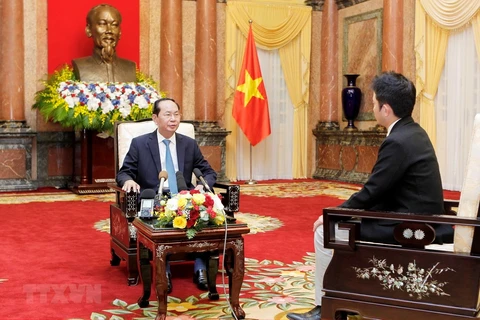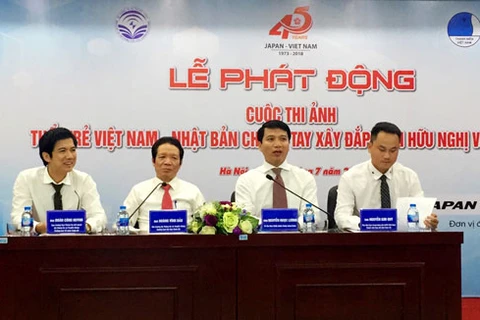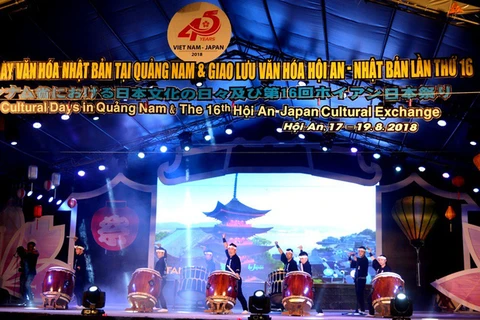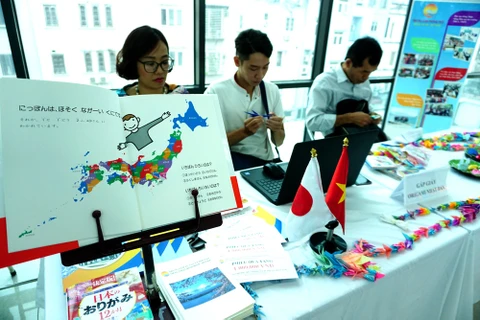 Nozomi Soejima (L) helps a patient in rehabilitation treatment at the Rehabilitation Centre of Bach Mai Hospital (Photo: VNA)
Nozomi Soejima (L) helps a patient in rehabilitation treatment at the Rehabilitation Centre of Bach Mai Hospital (Photo: VNA) Hanoi (VNA) – Nozomi Soejima is living out a dream she has had since she was a little girl. The Japanese occupational therapist has helped rehabilitate Vietnamese patients at the Rehabilitation Centre of Bach Mai Hospital in Hanoi for almost two years, as a Japan International Cooperation Agency (JICA) volunteer.
She works at the centre nine-to-five, overcoming difficulties in a new city and new community and becoming integrated into the local society as well as her workplace.
Aiming to help patients perform their own daily activities and improve their quality of life, Soejima has focused on providing them with therapies to improve their Activities of Daily Living (ADL) performance, while guiding their families to assist them and give them chances to serve themselves as exercises for a speedier recovery.
Nguyen Thanh Nam, one of Soejima’s co-workers, said the Japanese expert has changed his mindsets and other therapists’ at the centre, giving them a clearer understanding of the specific targets and standards of rehabilitation therapies, thus keeping them on the right track during treatment.
 Soejima has focused on providing the patients with therapies to improve their Activities of Daily Living (ADL) performance, thus improving their living quality (Photo: VNA)
Soejima has focused on providing the patients with therapies to improve their Activities of Daily Living (ADL) performance, thus improving their living quality (Photo: VNA) Along with treating patients, Soejima also helps train therapists at the centre, as Vietnam has little experience in the profession.
Together with sharing her experience with her Vietnamese peers, Soejima, with nine years of experience in rehabilitation before working in Vietnam, helps the centre build standards and test charts, contributing to the enhancement of capacity of the centre.
More than a year ago, the centre could handle just about 20 patients a day, and the number has increased to 60-70 at present.
Many of her patients, ageing from 10 to over 90, consider Soejima more than a therapist, but a friend.
Nguyen Huu Tuan, an active 10-year-old boy, had his right hand nerve cut by a piece of glass in an accident while he was driving his bicycle and could not move his index figure. Tuan has received treatment for nearly three months at the centre, where he has found a Japanese friend.
“She is unique,” said Tuan while proudly showing off a paper elephant Soejima taught him to make.
“Soejima is as gentle as my mother. If she goes back to Japan, I will surely miss her a lot,” said Tuan.
Soejima is one of the 66 JICA volunteers in Vietnam currently, who work for a two-year term.
According to JICA, the volunteers are engaged in many areas in Vietnam such as health care, social welfare, Japanese language teaching, local development, tourism, agriculture, fishery, industrial development and sports, contributing to social and human development.
As of March 2018, more than 600 Japanese volunteers had been sent to Vietnam to work in cities and provinces nationwide, using their skills, knowledge and experience to promote socio-economic development in Vietnam, and enhancing the friendship between the two countries.
Working in preschool education, Akari Tsuchiya, a skilled teacher with more than seven years experience in Japanese preschools, is a volunteer at Huong Sen Preschool run by the Centre for Women and Development under the Vietnam Women’s Union in Hanoi since October 2017.
 Akari Tsuchiya often makes teaching tools by her own from low-cost and recycled materials (Photo: VNA)
Akari Tsuchiya often makes teaching tools by her own from low-cost and recycled materials (Photo: VNA) The cheerful teacher came to Vietnam, making use of her own experience and adding to her skills by practicing activities together with her coworkers. During this time, she came to have an enriched understanding of the similarities in the education systems of Vietnam and her home country of Japan.
“At first, the children kept space from me and did not understand my Vietnamese. But now I am very happy that we have become very close to each other,” said Tsuchiya.
Tsuchiya teaches two classes with about 40 children aging from one to six at Huong Sen preschool.
During her music and movement activities as well as art classes with children, Tsuchiya has introduced Japanese games and arts to them, including Japan’s traditional Origami paper folding art.
“It is wonderful to have Tsuchiya here. We have learnt a lot from her, an enthusiastic teacher with great working attitude and love for children,” said Mai Lan Huong, manager of Huong Sen.
“The most impressive thing I find in Tsuchiya is her creativity. She always makes teaching tools herself from cost-saving and recycled materials, which I find very inspiring,” she added.
Huong said that while working together, Tsuchiya and Vietnamese teachers have regularly exchanged ideas to seek the most suitable methods and programmes for the children, ensuring their comprehensive growth.
Soejima and Tsuchiya are among many Japanese people who are silently contributing to reinforcing the sound relationship between Japan and Vietnam over the past 45 years, especially the friendship between Japanese and Vietnamese people.
According to the Vietnam-Japan Friendship Association, more than 260,000 Vietnamese are working, studying and living in Japan and nearly 20,000 Japanese are working in Vietnam.
Vietnam and Japan are enjoying the best development period in their 45-year-ties, especially since the two sides upgraded their relationship to the level of Extensive Strategic Partnership for Peace and Prosperity in Asia in 2014.
“If I have more opportunities, I will come back Vietnam, using my knowledge and skills to make more contributions to community development here,” stated Nozomi Soejima.-VNA
VNA
























